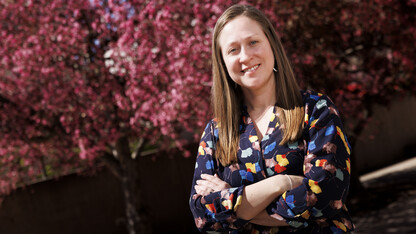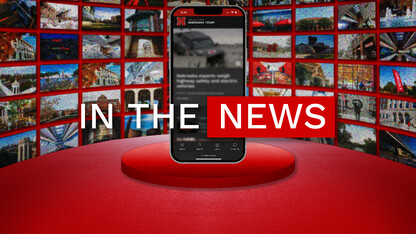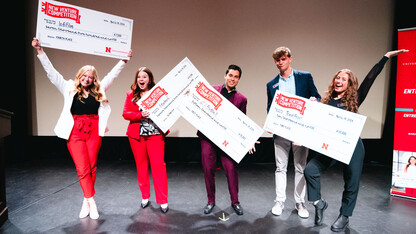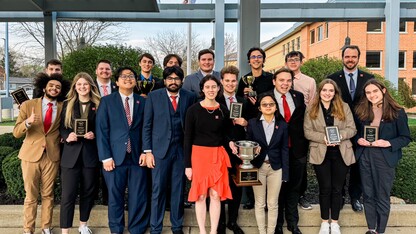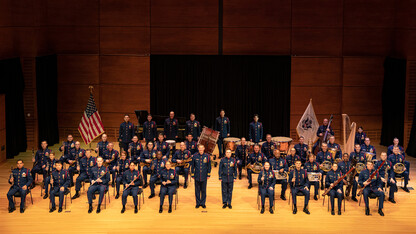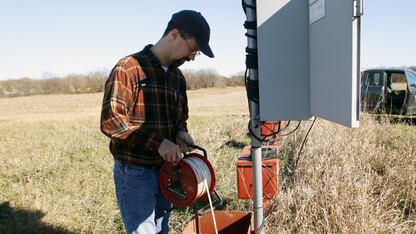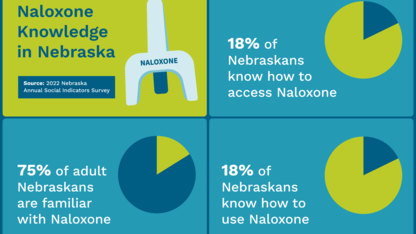· 9 min read
500+ national news mentions at Nebraska in ‘16

From Antarctica to Zika – with Donald Trump, drones and dark fishing spiders in between – the University of Nebraska-Lincoln attracted national media attention in 2016 for cutting-edge research, for higher-education leadership and for informed and reliable commentary on the most important events and issues of the year.
More than 500 national news stories mentioned the university, its people and its programs during 2016. University Communication regularly works with national media to connect reporters with faculty, staff, students and stories; appearances in the national media are logged at Nebraska in the News.
Discoverers, trailblazers and visionaries:
The Washington Post and other outlets reported in February on Antarctic research involving David Harwood and Christopher Fielding, Earth and atmospheric sciences. They helped coordinate research that extracted and examined a 3,375-foot-long rock sample drilled from beneath Antarctica’s McMurdo Sound. The drill core gave scientists a glimpse into Antarctica’s climate between 20 million and 14 million years ago and added new perspective on how increasing atmospheric carbon dioxide levels might affect Antarctica and Earth in the future. The Post also interviewed Harwood in September for a widely carried story about diatom fossils found atop Antarctic mountain ranges.
After the World Health Organization declared Zika-linked birth defects as a public health emergency, The Guardian quoted biologist Daniel Brooks on how climate change could be contributing to the spread of the mosquito-borne virus. Brooks is an adjunct research professor affiliated with the H.W. Manter Laboratory of Parasitology. Jiri Adamec, biochemistry, was featured in April’s High Plains Journal for his work with Brazilian authorities to speed up Zika testing in Amazonian areas by using the Novoplex card, a screening device he developed.
Carrick Detweiler, Sebastian Elbaum and Brittany Duncan, computer science and engineering; Dirac Twidwell, agronomy and horticulture; and Craig Allen, Nebraska Cooperative Fish & Wildlife Research, received extensive national coverage after a public test of their innovative fire-starting drone at Homestead National Monument near Beatrice, Nebraska, in April. The drone provides a safer way to start conservation fires to eliminate growth that endangers native species and increases the risk of wild fires. Wildfire Today announced the upcoming test in March.An Associated Press report on the April 21 test was carried by major outlets across the country; Popular Mechanics and Engadget also carried reports. As the group’s research continued, more stories appeared in July, August, and September.
Eileen Hebets, biological sciences, and her fellow spider scholars made frequent appearances in the national media with new discoveries and observations about spiders. Hebets and Alissa Anderson were cited in numerous stories in February and March for their study how male nursery-web spiders use spider-silk bondage to save themselves from death and cannibalism after mating. In May, the topic of research by Hebets and Jay Stafstrom was an unusual spider with gigantic eyes, used to capture bigger prey at night. That story, which originated with LiveScience, appeared in a number of outlets such as Mashable and CBS News. The Daily Mail in the UK likened the spider’s eyes to night vision goggles. The next big spider story came in October, when Hebets and former Nebraska spider researcher Steven Schwartz published findings that the female dark fishing spider’s habit of cannibalizing her mate leads to more and stronger offspring. The Economist sadly described the dark fishing spider’s habits as the “cruellest one-night stand of all.”
“The Bestseller Code,” a new book by Matthew Jockers, English, and his co-author and former student Jodie Archer received widespread coverage in August through November. Jockers and Archer used a supercomputer to analyze thousands of novels and detect patterns among which ones became bestsellers. The Wall Street Journal was among outlets that reported on their findings.
Snow-melting concrete under development by Chris Tuan, civil engineering, broke into the news just as a major snowstorm hit the East Coast in January. About a dozen major publications covered Tuan’s invention, including National Geographic, The Weather Channel, Huffington Post and Popular Mechanics. Tuan and colleague Lim Nguyen, engineering, gained more attention in November when they began working with a private company on a concrete variation that could be used to shelter against electromagnetic pulses.
The latest survey on college students’ use of digital devices in the classroom, conducted by Barney McCoy, journalism, appeared in hundreds of local TV and newspaper outlets after HealthDay reported on it on Jan. 26. McCoy’s study also was covered by Inside Higher Ed.
Rising stars and role models:
The Rural Law Opportunities Program, a new initiative that encourages rural high school students to consider law careers in rural areas, gained nationwide attention in December after the Associated Press and Harvest Public Media produced stories on the effort. Qualifying students get free tuition at three undergraduate institutions serving rural Nebraska and guaranteed admission at the Nebraska College of Law. Interim Law Dean Richard Moberly played a leading role in developing the program.
The College of Law also got notice from the National Law Journal in July for its Build Your Character program, which includes a mobile app that helps law students track their progress in building the skills they need for successful careers.
Jennine Capó Crucet, English, described what it’s like to be a first-generation college student in a video essay that aired on PBS NewsHour.
The New York Times in May featured Sidy Ndao, engineering, and his efforts to improve science, technology, engineering and math education in West Africa. Ndao was born in Senegal.
Poets and Quants, which covers U.S. business schools, featured a lengthy question-and-answer interview with Donde Plowman, College of Business Administration dean, in October. Plowman was tapped in December to become executive vice chancellor, the university’s chief academic officer.
Amy Goodburn, academic affairs, described Nebraska’s efforts to improve retention and graduation rates for its first-generation, low-income and minority students for a Stateline review of such efforts in March.
Trusted experts and recognized authorities:
As Donald Trump made his way to the White House, reporters from the region and the nation turned to political scientists John Hibbing, Kevin Smith and Ingrid Haas and others to explain how emotions and biology might be affecting voter behavior. In a May 2 column for the Washington Post’s Monkey Cage political science blog, Hibbing and Elizabeth Theiss-Morse, political science, offered a reason for Trump’s popularity by discussing their research that found many Americans dislike the debate and compromise that makes democracy “messy.” In June, the Atlantic cited the same research in a lengthy article describing how American democracy went “insane.” In December, Hibbing penned an article at the Monkey Cage about how threat sensitivity illuminated Trump’s rise. Vox.com talked to Haas, a political psychologist, in the wake of the nightclub shooting in Orlando that left 50 dead. She said that when people feel uncertain and fearful, they become more politically intolerant. That article also referred to Hibbing and Smith’s groundbreaking research on the biological underpinnings of politics.
In November, reporters from New York NPR affiliate NYC sought the help of Smith and his colleague Jeffrey French from the University of Nebraska Omaha as they reported on how stress affected American voters. The WNYC report aired on a several NPR programs and podcasts.
Science interviewed Kenneth Bloom, physics, for an August report that additional experiments at the Large Hadron Collider at CERN in Switzerland had ruled out what had been thought to have been the discovery of a new particle in early 2016. It would have been the first wholly unexpected particle in decades.
The National Archives turned to Whitman scholar Kenneth Price, English, after a volunteer found a letter possibly written by poet Walt Whitman in a Civil War widow’s pension file. Price confirmed the letter was written by Whitman. It is the third example of a “soldier letter” that Whitman wrote on behalf of injured and dying soldiers as part of his hospital volunteer work during the Civil War. The Washington Post, National Public Radio and Smithsonian Magazine were among the outlets reporting on the find.
Wheeler Winston Dixon, film studies, served as a reliable source for many reporters across the nation covering film and popular culture. His name appeared almost every month on topics as wide-ranging as a top-selling Mozart CD collection, Christian Science Monitor in December; to the current popularity of “true crime” stories, Entertainment Weekly in January. He also commented on corporate Hollywood, movies based on video games and the absence of nonwhite nominees in the 2016 Oscar slate.
The U.S. Drought Monitor, a partnership led by the University of Nebraska-Lincoln’s Drought Mitigation Center, served as a go-to expert for news outlets across the country as they reported on drought conditions. The Washington Post cited the monitor in a February report about continuing drought in California. The center’s Deborah Bathke, was quoted in a June Public News Service report on looming drought in Iowa. More than a dozen outlets cited the center in July, as drought began to impact Massachusetts, New York, New Hampshire and other states in July. Denise Gutzmer was interviewed by the Louisville Courier-Journal for a report on that city’s efforts to use its good quality water supplies as an economic development marketing tool. Drought in Arkansas, Georgia and New England generated many stories based upon the Center’s work in August. Climatologist Mark Svoboda was interviewed by New England Public Radio for an Aug. 29 story carried nationally by the Here & Now news program out of Boston. Drought and wildfires prompted dozens more citations in November and December, including a Nov. 4 report by the Associated Press that autumn rains had eased drought conditions in California.
Matt Waite, founder of the drone journalism laboratory and the author of a new manual on newsroom drone operations, was a popular source for reporters covering drone regulations and other developments in the drone world. The Washington Post talked to him in January about obstacles facing package deliveries by drone. In June, he was quoted by dozens of news organizations after the FAA announced its new drone regulations. In July, he was quoted in a national report on how states are regulating drones and in August, he spoke to National Public Radio and Forbes about the rules governing the commercial use of drones.
Moon terraforming (July, Forbes), space burials (August, U.S. News & World Report) and Mars missions (September, Popular Science) were among the topics that led reporters to seek out Frans von der Dunk, law.
Faculty, administration, student and staff appearances in the national media are logged here. To review month-by-month stories highlighting the university’s national news mentions click here. If you have additions to this list or suggestions for national news stories, contact Leslie Reed, the university’s national news editor, at lreed5@unl.edu or 402-472-2059.
